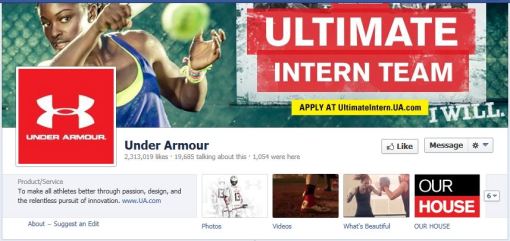David (Under Armour) versus Goliath (Nike)
In February 2013, USA Today reported that sports apparel rival Under Amour is taking on its giant competitor Nike over trademark infringement of the “I Will” slogan. After reading that story, I started wondering if relatively new (1995) to the sports appeal game, Under Amour, could take on the more established (1971 but started earlier) sports apparel behemoth Nike in the fast-paced social media game.
Upon first glance, it would appear that both brands have a similar social media strategy. Each Tweets, posts to Facebook and promotes videos on Youtube. They both use a variety of social networks to engage over a variety of sports related topics, fitness strategies and sports personalities. Both appeal companies have established a variety of engagement channels around specific sports and gender such as Nike Football and Nike Soccer or Under Amour Women.
Where the competitors seem to part ways is in the scale and scope. As you would think, Nike is leading the way on Facebook with 12,627,155 likes, 69,869 talking about this, 11,173 were here as of April 14. On Twitter, they have 1,024,473 followers and more than 11,000 tweets. An example of the grand scale or scope to which Nike engages through social networks is their 2012 Olympics campaign. This campaign celebrated every day athletes and according to Socialbakers’ CheerMeter there were more than 16,000 tweets associating Nike with the word Olympic between July 27 and August 2. In addition. Nike attracted 166,718 new Facebook fans during the Games.
 In comparison, Under Amour only has 186,966 Twitter followers and a little more than 6,500 tweets. On Facebook, they have 2,313,156 likes, 19,685 talking about this and a mere 1,060 were here. It would appear that Under Amour is out of its league trying to play on the same field as its larger, more seasoned competition Nike. I would contend there is more to the story and Under Armour while having the smaller numbers is laser focused on their target audience. “Our goal overall — when I got here a year ago — was to look at growing the audience and making sure we’re getting the right audience, which is 12- to 24-year-olds,” says Digital Media Director Dan Mecchi. To do so, “we activate our athletes — Michael Phelps, Lindsey Vonn — around our teams, whether they’re high school, college or the Ravens or Patriots.” Mecchi says this approach gets people involved with Under Armour in a cost-effective way.
In comparison, Under Amour only has 186,966 Twitter followers and a little more than 6,500 tweets. On Facebook, they have 2,313,156 likes, 19,685 talking about this and a mere 1,060 were here. It would appear that Under Amour is out of its league trying to play on the same field as its larger, more seasoned competition Nike. I would contend there is more to the story and Under Armour while having the smaller numbers is laser focused on their target audience. “Our goal overall — when I got here a year ago — was to look at growing the audience and making sure we’re getting the right audience, which is 12- to 24-year-olds,” says Digital Media Director Dan Mecchi. To do so, “we activate our athletes — Michael Phelps, Lindsey Vonn — around our teams, whether they’re high school, college or the Ravens or Patriots.” Mecchi says this approach gets people involved with Under Armour in a cost-effective way.
 An example of how Under Armour is engaging with their target audience in a more cost effective way than Nike is their Ultimate Intern campaign which they asked college students to blog, video and interview athletes to compete for two internship opportunities. The finalists were interviewed via Skype. Another example of Under Amour competing on a smaller scale is their sponsorship of the 2012 NFL Combine were potential young NFL candidate display their athletic talents to potential teams for draft day. This campaign included letting industry insiders actually tweet their experiences of the day on behalf of @underamour. In my opinion, these simply campaigns have garnered Under Amour under estimated brand power and credibility with their target audience.
An example of how Under Armour is engaging with their target audience in a more cost effective way than Nike is their Ultimate Intern campaign which they asked college students to blog, video and interview athletes to compete for two internship opportunities. The finalists were interviewed via Skype. Another example of Under Amour competing on a smaller scale is their sponsorship of the 2012 NFL Combine were potential young NFL candidate display their athletic talents to potential teams for draft day. This campaign included letting industry insiders actually tweet their experiences of the day on behalf of @underamour. In my opinion, these simply campaigns have garnered Under Amour under estimated brand power and credibility with their target audience.
In comparing these two companies, Nike has far more followers and fans, however I contend that Under Amour is more engaged with their limited targeted audience. They are doing more engagement with less resources and brand recognition. My argument may be validated by the recent announcement that Nike would be taking their social media in-house as an effort to get closer to its fans.
Sounds like Nike may be stealing a play from Under Armour’s social media playbook.
References
Miller, M., (2011) Under Armour. Brand Channel. Retrieved April 13 from http://www.brandchannel.com/features_webwatch.asp?ww_id=520
Weissman, S., (2013). Under Armour’s social media internship challenge, Retrieved April 13 from http://www.digiday.com/brands/under-armours-social-media-internship-challenge/
Drell, L., (2012) 5 fitness brands kicking butt on social media, Retrieved on April 14 from http://mashable.com/2012/01/06/fitness-brands-social-media/
Laird, S., (2012) How Under Armour wants to socially dominate the NFL draft combine, Retrieved April 13 from http://mashable.com/2012/02/24/under-armour-nfl-draft-combine/
Sallow, E., (2011) How Nike Outruns the social media competition, Retrieved April 13 from http://mashable.com/2011/09/22/nike-social-media/
Ruiz, J., (2013) SoMolo marketing: a Nike case study. Retrieved April 14 from http://socialmediatoday.com/joseph-ruiz/1188271/somolo-marketing-nike-case-study
Joseph, S. (2013) Nike takes social media in house. Marketing Week. Retrieved April 14 from http://www.marketingweek.co.uk/sectors/sport/nike-takes-social-media-in-house/4005240.article




